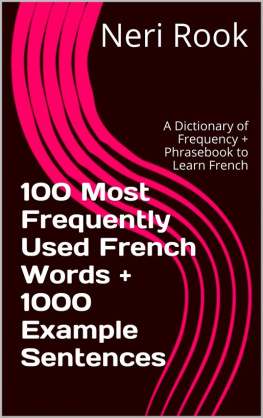A Frequency Dictionary of French
A Frequency Dictionary of French is an invaluable tool for all learners of French, providing a list of the 5000 most frequently used words in the language. Based on a 23-million-word corpus of French which includes written and spoken material both from France and overseas, this dictionary provides the user with detailed information for each of the 5000 entries, including English equivalents, a sample sentence, its English translation, usage statistics, and an indication of register variation. Users can access the top 5000 words either through the main frequency listing or through an alphabetical index. Throughout the frequency listing there are thematically organized lists of the top words from a variety of key topics such as sports, weather, clothing, and family terms. An engaging and highly useful resource, the
Frequency Dictionary of French will enable students of all levels to get the most out of their study of French vocabulary.
Yvon Le Bras is Associate Professor of French and Department Chair of the French and Italian Department at Brigham Young University (Provo, Utah).
Routledge Frequency Dictionaries
- General Editors:
- Paul Rayson, Lancaster University, UK
- Mark Davies, Brigham Young University, USA
- Editorial Board:
- Michael Barlow, University of Auckland, New Zealand
- Geoffrey Leech, Lancaster University, UK
- Barbara Lewandowska-Tomaszczyk, University of Lodz, Poland
- Josef Schmied, Chemnitz University of Technology, Germany
- Andrew Wilson, Lancaster University, UK
- Adam Kilgarriff, Lexicography MasterClass Ltd and University of Sussex, UK
- Hongying Tao, University of California at Los Angeles
- Chris Tribble, Kings College London, UK
- Other books in the series:
- A Frequency Dictionary of Mandarin Chinese
- A Frequency Dictionary of German
- A Frequency Dictionary of Portuguese
- A Frequency Dictionary of Spanish
- A Frequency Dictionary of Arabic (forthcoming)
A Frequency Dictionary of French
Core vocabulary for learners
Deryle Lonsdale and Yvon Le Bras

First published 2009
by Routledge
2 Park Square, Milton Park, Abingdon, Oxon OX14 4RN Simultaneously published in the USA and Canada
by Routledge
270 Madison Ave, New York, NY 10016
Routledge is an imprint of the Taylor & Francis Group, an informa business This edition published in the Taylor & Francis e-Library, 2009.
Routledge Frequency Dictionaries
- General Editors:
- Paul Rayson, Lancaster University, UK
- Mark Davies, Brigham Young University, USA
- Editorial Board:
- Michael Barlow, University of Auckland, New Zealand
- Geoffrey Leech, Lancaster University, UK
- Barbara Lewandowska-Tomaszczyk, University of Lodz, Poland
- Josef Schmied, Chemnitz University of Technology, Germany
- Andrew Wilson, Lancaster University, UK
- Adam Kilgarriff, Lexicography MasterClass Ltd and University of Sussex, UK
- Hongying Tao, University of California at Los Angeles
- Chris Tribble, Kings College London, UK
- Other books in the series:
- A Frequency Dictionary of Mandarin Chinese
- A Frequency Dictionary of German
- A Frequency Dictionary of Portuguese
- A Frequency Dictionary of Spanish
- A Frequency Dictionary of Arabic (forthcoming)
A Frequency Dictionary of French
Core vocabulary for learners
Deryle Lonsdale and Yvon Le Bras

First published 2009
by Routledge
2 Park Square, Milton Park, Abingdon, Oxon OX14 4RN Simultaneously published in the USA and Canada
by Routledge
270 Madison Ave, New York, NY 10016
Routledge is an imprint of the Taylor & Francis Group, an informa business This edition published in the Taylor & Francis e-Library, 2009.
To purchase your own copy of this or any of Taylor & Francis or Routledges collection of thousands of eBooks please go to www.eBookstore.tandf.co.uk. 2009 Deryle Lonsdale and Yvon Le Bras All rights reserved. No part of this book may be reprinted or reproduced or utilised in any form or by any electronic, mechanical, or other means, now known or hereafter invented, including photocopying and recording, or in any information storage or retrieval system, without permission in writing from the publishers. British Library Cataloguing in Publication Data
A catalogue record for this book is available from the British Library Library of Congress Cataloging in Publication Data
Lonsdale, Deryle.
A frequency dictionary of French : core vocabulary for learners / Deryle Lonsdale, Yvon Le Bras.
p. cm.
Includes index.
1. I. I.
Lonsdale, Deryle. II. Title.
PC2691.L66 2009
443.21dc19 2008042400 ISBN 0-203-88304-7 Master e-book ISBN ISBN10: 0-415-77531-0 (pbk)
ISBN10: 0-415-77530-2 (hbk)
ISBN10: 0-203-88304-7 (ebk) ISBN13: 978-0-415-77531-1 (pbk)
ISBN13: 978-0-415-77530-4 (hbk)
ISBN13: 978-0-203-88304-4 (ebk)
Contents
There is a growing consensus that frequency information has a role to play in language learning. Data derived from corpora allows the frequency of individual words and phrases in a language to be determined. That information may then be incorporated into language learning. In this series, the frequency of words in large corpora is presented to learners to allow them to use frequency as a guide in their learning.
In providing such a resource, we are both bringing students closer to real language (as opposed to textbook language, which often distorts the frequencies of features in a language, see Ljung 1990) and providing the possibility for students to use frequency as a guide for vocabulary learning. In addition we are providing information on differences between frequencies in spoken and written language as well as, from time to time, frequencies specific to certain genres. Why should one do this? Nation (1990) has shown that the 4,0005,000 most frequent words account for up to 95 per cent of a written text and the 1,000 most frequent words account for 85 per cent of speech. While Nations results were for English, they do at least present the possibility that, by allowing frequency to be a general guide to vocabulary learning, one task facing learners to acquire a lexicon which will serve them well on most occasions most of the time could be achieved quite easily. While frequency alone may never act as the sole guide for a learner, it is nonetheless a very good guide, and one which may produce rapid results. In short, it seems rational to prioritize learning the words one is likely to hear and use most often.
That is the philosophy behind this series of dictionaries. The information in these dictionaries is presented in a number of formats to allow users to access the data in different ways. So, for example, if you would prefer not to simply drill down through the word frequency list, but would rather focus on verbs, the part of speech index will allow you to focus on just the most frequent verbs. Given that verbs typically account for 20 per cent of all words in a language, this may be a good strategy. Also, a focus on function words may be equally rewarding 60 per cent of speech in English is composed of a mere 50 function words. We also hope that the series provides information of use to the language teacher.













